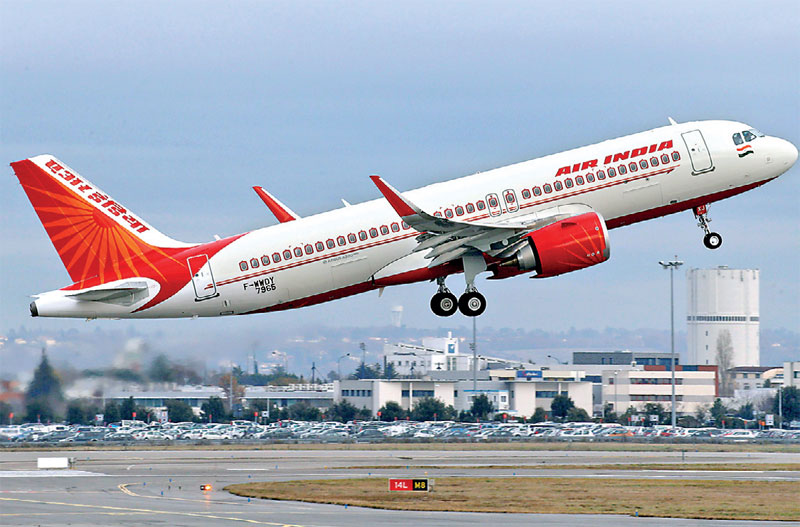Monday Dec 22, 2025
Monday Dec 22, 2025
Thursday, 21 October 2021 02:33 - - {{hitsCtrl.values.hits}}

 Finally, after 18 months of unremitting bad news, there is a glimmer of resurgence in the region’s airline industry. The Government of India has announced that the Tata Group, one of the subcontinent’s oldest and most respected conglomerates, emerged as the winning bidder for the National Aviation Company of India Ltd., which houses Air India and Indian Airlines.
Finally, after 18 months of unremitting bad news, there is a glimmer of resurgence in the region’s airline industry. The Government of India has announced that the Tata Group, one of the subcontinent’s oldest and most respected conglomerates, emerged as the winning bidder for the National Aviation Company of India Ltd., which houses Air India and Indian Airlines.
The other bidder, a group led by Spicejet’s Chairman Ajay Singh, was outbid by about INR 3,000 crore (one crore is 10 million), with Tata paying INR 18,000 crore ($ 2.4 billion) for the airline. This includes $ 360 million in cash (mainly for aircraft) and accepting INR 15,300 crore ($ 2 billion) in debt.
The remaining $ 6 billion owed by the airline will be absorbed by a special purpose vehicle (SPV) set up by the Government. This marks the end of a long and exhausting privatisation process for Air India that lasted over two decades.
Tata Air services
Founded by J.R.D. Tata in 1932 as Tata Air Services, the airline which had Colombo as its first overseas destination was renamed Air India in 1946. Consistently profitable, Air India was nationalised by the Indian Government in 1953, but such was JRD’s passion for his airline, that he continued to serve as Chairman without taking any compensation.
The airline continued to prosper under his leadership, remaining profitable and becoming the first airline in the world to have an all-jet fleet, in 1962.
JRD, who was heard to remark that his role was to “save the airline from the politicians”, was finally forced into retirement in 1978, after 40 years at the helm.
Descending into turbulence
Air India continued to do well for several years after JRD’s retirement, but slowly lost focus. Militant unions, protected by compliant politicians, chipped away at the focus and business ethic infused by the great man, until it was merged with Indian Airlines (the State-owned domestic carrier) in 2007. The combined entity has been mired in debt and controversy ever since, with a poor safety record and spiralling losses.
What does Tata get for $ 2.3 billion?
Tata Group will control 100% of Air India (AI) and its low-cost (LCC) arm Air India Express (AX). The airline’s ground handling unit is part-owned by Singapore’s SATS, Tata will also get the Government’s 50% share in this venture.
Having been badly affected by the pandemic, Air India will need extensive ‘surgery’ to recover. With a motley collection of 143 aircraft, fleet rationalisation will be high on the new agenda.
Many of the aircraft are old and need replacing, including four Boeing 747-400s that are unlikely to return to service. Of the 18 aging Boeing 777s, two are configured for VIP travel, and whether the airline will continue to operate these, remains unknown.
The Boeing 777s and 787s will remain the core of AI’s long-haul fleet, with the Airbus A320 family of aircraft (58 of which are airworthy) and 24 Boeing 737s belonging to AX being used on shorter routes. A large order for narrow-body types and an expensive cabin refurbishment program are likely to be some of the urgent necessities, as Tata tries to bring the airline back to its former glory.
Tata may dominate the Indian market
Tata already has the controlling stakes in Air Asia India (IAD), a joint venture LCC (Air Asia of Malaysia holds 16% of the shares), and Vistara, a full-service airline jointly owned by Singapore Airlines. Vistara has 37 Airbus 320 series aircraft, plus another 29 on order, two Boeing 787s (with orders for four more), and six Boeing 737s with which the carrier launched operations in 2015.
Air Asia India commenced operations in 2014 and has 33 A320 series aircraft, with a primary base in Bengaluru (Bangalore) for its extensive domestic service.
With the acquisition of Air India, Tata now has a sprawling airline empire comprising more than 220 aircraft scattered over multiple bases, with several different business plans and varying sales channels. Some degree of consolidation is urgently needed if all these different elements are to work together.
A huge and competitive market
India is, with the US and China, potentially one of the world’s largest airline markets. Realising this potential, though, has proved to be difficult. For an airline venture to be successful, it needs two key factors: a strong domestic market and a reliable number of passengers who travel on the long-haul sectors frequently.
Industry experts estimate that a full-service airline needs around 50,000 premium passengers a year travelling in and out of its hub to reach the ‘critical mass’ required for profitability. Airlines that depend on tourist and visiting friends and relatives traffic need to deploy a different business model for success.
While India has both domestic and premium business passengers in abundance, the market has been ceded to other players. Pre-pandemic the ‘Gulf Sisters’ to the west and the likes of Singapore Airlines and Cathay Pacific to the east, had chipped away at India’s long-haul market. With a level of service and reliability that the perennially cash-strapped Air India could never match, the foreign airlines between them secured a huge share of the premium traffic in and out of India.
The pandemic has, however, levelled the playing field, to some extent. As the region slowly recovers there is an opportunity for an aggressive, well-managed airline to gain considerable market share.
Leaving aside the threats from the ‘Gulf Sisters’ and Asian giants, India has a vibrant and profitable domestic sector. Indigo Airlines (IGO) is widely regarded as the most successful LCC in the region, though it is currently embroiled in a legal dispute between its founders. Despite this, with a fleet of more than 200 aircraft (all Airbus A320s) and orders for another 300, Indigo remains a formidable competitor.
Spicejet (SEJ), owned by Ajay Singh, the other bidder for Air India, already has more than 75 Boeing 737s and holds orders for another 190. SEJ also has a small all-cargo fleet that has helped it survive through the pandemic.
What will the future hold?
India’s market is large enough for all three of these groups to survive and prosper. As China has shown the world there is ample room for multiple large airlines in a growing economy. But there is a clear and unbreakable link between a country’s GDP and the viability of airlines that cater to that market. In the first instance India’s economy has to recover strongly and continue to grow, if all these players are to survive.
The other ‘fly in the ointment’ is Air India’s large and vocal employee groups. As pointed out by a sister paper of the Daily FT recently (‘Prodigal son, returned’) AI’s staff have long been used to milking the airline for their own benefit with little regard for the company’s finances, a pattern of behaviour that is typical of the region’s State-owned airlines.
Changing this mindset and bringing back some much-needed corporate discipline, while fighting off the challenges in both domestic and international markets will not be an easy task. Added to that, the privatisation agreement states that for one year no changes can be made to staffing levels at Air India, making rapid change impossible.
In some ways this resembles a fairy tale, with Air India returning to the Tata Group. But JRD did not have any children and while the group bears his name, the current Chairman Natarajan Chandrasekaran is no relative. It will be fascinating to observe whether Tata Group has the understanding of the airline business, access to capital, management skills, and endurance, to prevail in a pitiless industry that has buried many great airlines.